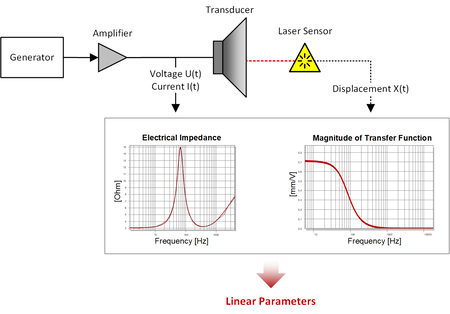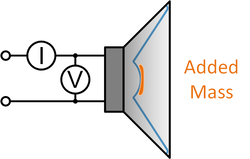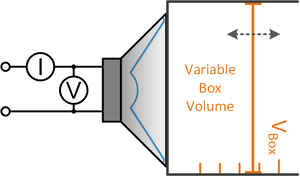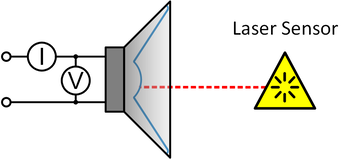Linear Parameter Measurement (LPM)
Features and Benefits
- Identifies linear transducer model (Thiele / Small parameters)
- Measures suspension creep
- Single-step measurement with laser sensor
- Two-step measurement with additional mass or test enclosure
- Monitors signal to noise + distortion ratio (SNR+D) and noise floor
- Automatic validity check
- High reliability and reproducibility
- Fast measurement
The Linear Parameter Measurement (LPM) module of the KLIPPEL Analyzer System is dedicated to identifying the electrical and mechanical small signal (Thiele/Small) parameters of electro-dynamical transducers with high accuracy. It is based on the electrical impedance by measuring the voltage and current at the speaker terminals. Enhanced by an optional laser displacement sensor, the identification does not require a second measurement and thus avoids common problems of the traditional two-step methods (e.g. added mass). An additional benefit of the displacement measurement is the identification the suspension creep parameters, resulting in better accuracy of the loudspeaker model at low frequencies. The LPM provides tools to identify and avoid typical problems such as poor signal to noise ratio and malfunction due to nonlinear effects of the driver or amplifier limiting.
Specification
Standard Measurements Performed by LPM
Requirements
Hardware
• KLIPPEL Analyzer 3
Software
• dB-Lab software
Accessories
• Power amplifier or KA3 Amplifier Card
• Laser sensor (optional)
• PC
• It is recommended to use coating spray for micro-speakers and tweeters with transparent and shiny
diaphragms. More information.
Technique
A second measurement is performed while a known mass Madd is added to the cone.
Advantages
Simple technique
Mms is measured primarily
Problems
Cannot be applied to tweeter and microspeakers
Time consuming
Mechanical resistance or stiffness are assumed as frequency independent para
Technique
A second measurement is performed while a known air stiffness Kair is added to the suspension.
Advantages
Simple technique
Cms is measured primarily
Problems
Depends highly on precise value of effective radiation area Sd
Residual air volume (inside the transducer) cannot be considered
Requires sealed diaphragm
Cannot be used to measure mechanical mass without air load
Time consuming
Technique
In addition to the voltage and current also the voice coil vibration (e.g. displacement) is measured by using an optical sensor.
Advantages
Fast (one step technique)
Simple to use
BI is measured primarily
Most precise results
Can be applied to most transducers
Problems
Optical problems (angle, surface)
Coil displacement is not axial-symmetrical
Related Information
Other Modules of the R&D System
• Large Signal Identification (LSI):
• Linear Simulation (LSIM):
Fast and comprehensive simulation of the linear transfer behavior of transducers and passive/active
loudspeaker systems
• Impedance Task (IMP):
Linear Parameter Measurement (TS-Parameter)
• T/S Parameter Laser Fitting (TSX) add-on for IMP:
Thiele Small parameter identification with laser
Application Notes
• AN 16 Multitone Distortion
• AN 25 Maximizing LPM Accuracy
Literature and Papers
• Fast and Accurate Linear Parameter Measurement
Standards
International Electrotechnical Commission
IEC 60268-5, IEC 60268-7, IEC 60268-22, IEC 62458, IEC 62459, IEC WD 63034
European Standards
BS EN 54-24
Audio Engineering Society
AES2
Institute of Electrical and Electronics Engineers
IEEE 269, IEEE 1206, IEEE 1329, IEEE 1652




